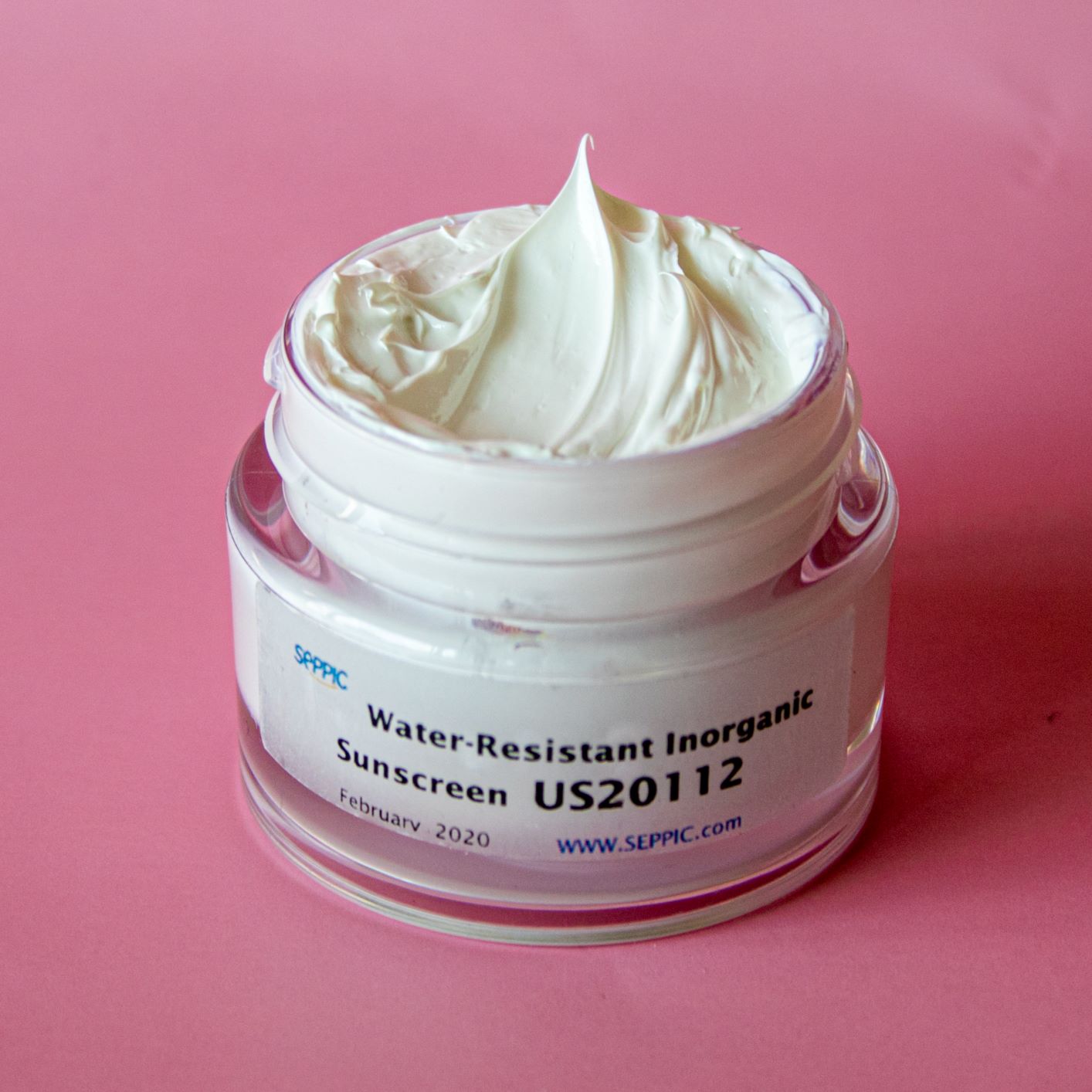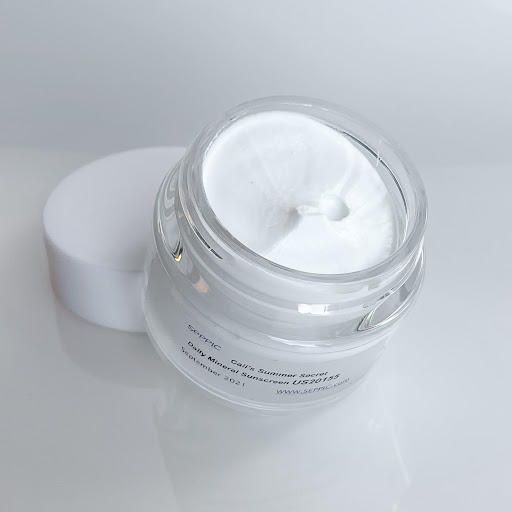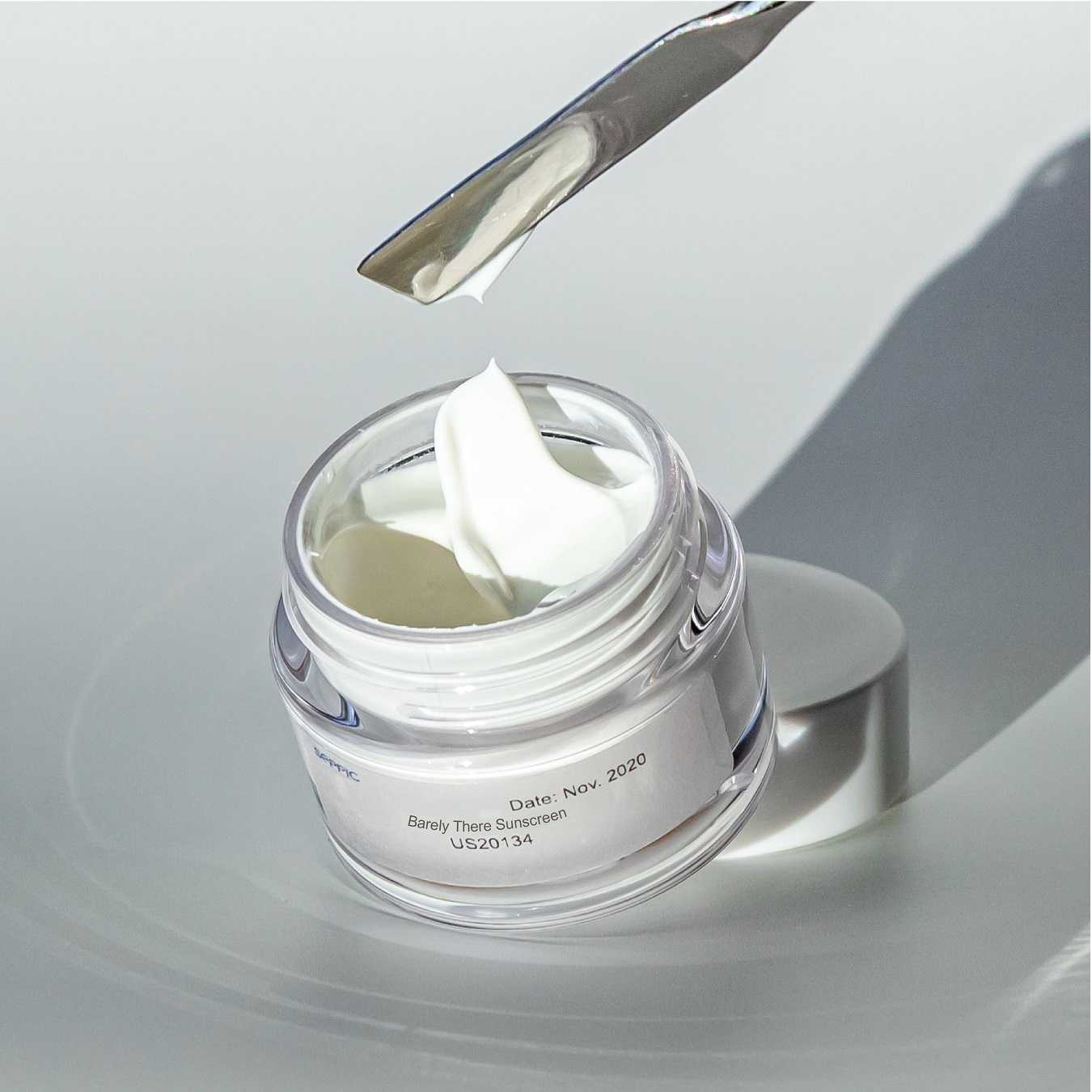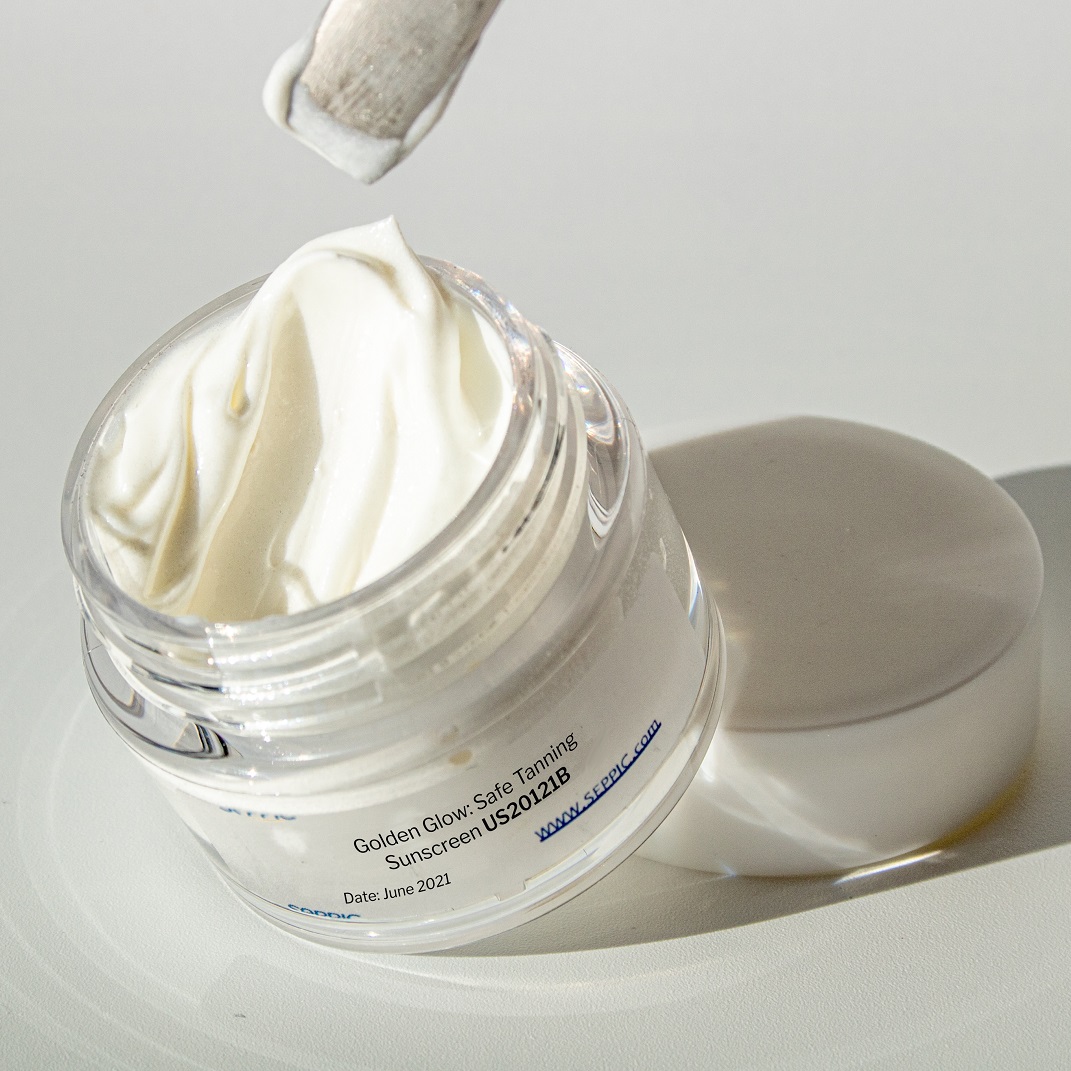
Sun Care Questionnaire
January 14, 2022
Dreaming about summer? Me too! That’s why I decided to write about all of Seppic’s sun care materials - while cuddled up with a warm cup of coffee and a blanket 😆
Sun care formulations can be a bit tricky - especially with a high SPF and inorganic sunscreens - but don’t worry, Seppic has tons of ingredients that can stabilize all your sun care formulas and even has active ingredients to bring added benefits!
How sunscreens work?
The key ingredient to suncare products is of course the sunscreens (or sun filters), that will protect from the sun rays. There are two types of sunscreens: organic sunscreens (also called “chemical” sunscreens) and inorganic sunscreens (mineral, or physical sunscreens).
Organic sunscreens (Avobenzone, Octocrylene, Homosalate,...) absorb UV radiation through their chemical bonds, thus protecting the skin, while inorganic sunscreens (ZnO, TiO2) physically block the rays by reflecting or scattering them away from the skin.
Organic sunscreens come in oil form, so they allow the formulation of a variety of products (including fluid products and clear oils) but can feel tacky, while inorganic sunscreens come in white powder form (or dispersion). They are considered safer, but are harder to formulate as they are charged and not easy to disperse and stabilize.
Not only is formulating sunscreen a technical challenge, but ensuring a nice application that makes reapplication enjoyable is an even greater challenge!
What are the main challenges when formulating suncare?
Stability: especially by using ingredients compatible with inorganic sunscreens
SPF: Improve the sunscreens dispersion and spreadability for the best protection
Skin feel: ensure the final product is easy to use, with a nice skin feel, to applied and reapplied
Water resistance: to be protected longer and in any situation
Safety and sustainability: for the consumer and the environment
Q&A!
Stabilization
Formulating sun care products is challenging, especially with charged mineral sunscreens and high filters %.
What is the best polymer to suspend and stabilize mineral sunscreens?
SEPIMAX ZEN™ is the best choice to suspend particles like mineral sunscreen, even at low viscosity, thanks to its high yield value.
INCI: Polyacrylate Crosspolymer-6
Which polymer can I use to stabilize most of my suncare products?
SEPINOV™ EMT 10, it’s the most polyvalent polymer, thickening and stabilizing oil in cream gels or emulsions, compatible with inorganic & organic sunscreens.
INCI: Hydroxyethyl Acrylate/Sodium Acryloyldimethyl Taurate Copolymer

Which natural emulsifiers are recommended for comfortable sun care applications?
MONTANOV™ 82, associated with MONTANOV™ 202 or MONTANOV™ 68 MB non ionic lamellar emulsifiers. They have outstanding emulsifying properties and are compatible with all types of sunscreens.
While MONTANOV™ 82 provides a soft and rich skin feel (like MONTANOV™ 68 MB) and has demonstrated its effectiveness in emulsions rich in organic filters (as seen in the EU07368 formula), MONTANOV™ 202 creates light emulsions and is especially efficient with mineral sunscreen, as seen in our recent formula US20155.
US20155 (opens new window) Cali's Summer Secret Daily Mineral Sunscreen

Sprayable textures
A sentence on how easy-to-use is important for sun care to make sure the product is used (Aerosol spray formulation for instance)
Which emulsifier allows to formulate sprayable suncare emulsions?
FLUIDIFEEL™ EASY. It is a natural emulsifier, cold or hot processable, creating fluid & sprayable emulsions. It has a very good compatibility with sun filters and brings a light and soft skin feel.
Tip: Add a hinch of Solagum™ AX or Sepimax™ Zen to help stabilize the most challenging formulas!
INCI: Lauryl Glucoside & Myristyl Glucoside and Polyglyceryl-6 Laurate
EU07549 (opens new window) Body Sunguard
How to stabilize a sprayable suncare formula?
With SIMULGEL™ NS. This polymer is the expert for sprayable & ultra-fluid formulas, creating gel resistant to UV exposure (unlike conventional acrylates polymers), while helping to reinforce the skin barrier of impaired skin (tested in vitro on 3D skin models). With a quick break effect & fresh texture, it is ideal for hot, long days outside!
INCI: Hydroxyethyl Acrylate/Sodium Acryloyldimethyl Taurate Copolymer & Squalane & Polysorbate 60
Water resistance
How can I create a water resistant and non tacky suncare emulsion?
With Sensanov™ WR emulsifier. Compatible with both types of sunscreens, it creates light and spreadable O/W formulations with water resistance properties (tested in vivo). It can be used instead of film forming polymers, avoiding their tacky effect.
INCI: C20-22 Alkyl Phosphate & C20-22 Alcohols
US20134 (opens new window) Barely There Sunscreen

SPF enhancement
Apart from increasing the % of sun filters, improving their dispersion (for mineral filters) and helping their solubilization (organic filters) help enhancing the suncare protection efficacy (and allows the addition of more sunscreens as well!).
Which emollient can help improve the dispersion of mineral sunscreens with a light and non sticky skin feel?
EMOSMART™ L19 & EMOGREEN™ L15 biodegradable alkanes. They disperse inorganic sunscreens as effectively as the C12-15 Alkyl Benzoate reference (DUB B1215*), and they help maintain a smooth appearance of the emulsion overtime.
INCI: C15-C19 Alkanes
Which emollient helps dispersing mineral sunscreens with a cushion skin feel?
DUB SSIC* ester. It displays excellent dispersing properties while leaving a long-lasting cushion and powdery feel on the skin.
INCI: Isocetyl Stearoyl Stearate
To enhance organic Sunscreens solubilization:
Which solutions do you have to help solubilize organic sunscreens and boost the SPF?
DUB HELIOPTIMA* & DUB SYNERSOL*. These two optimized combinations of esters help solubilize organic filters, with SPF boosting results and enhanced sensory.
INCI: Diisopropyl adipate (and) Propylene glycol dicaprylate/dicaprate (and) C12-15 alkyl benzoate (and) Diisopropyl sebacate
INCI: Isodecyl neopentanoate (and) diisopropyl sebacate (and) lauryl lactate
Sensory
Between the tacky organic filters and the draggy mineral filters, dispersing and solubilizing emollients that we’ve seen before are key to improving the skin feel of suncare! Some ingredients are especially suitable for sun care, for the glide they provide, with a light powdery skin feel.
How to reduce the stickiness of the sun care and avoid the sand sticking on?
With EMOSMART™ & EMOGREEN™ alkanes. These non polar emollients not only improve the spreadability of the formula, but also reduce the sticky effect, avoiding the sand to stick on the skin. They leave a soft powdery feel after application.
Tips: Combine DUB SSIC*/ EMOGREEN™ L15 (50/50) for the right balance between great inorganic sunscreen dispersion and ideal skin feel.
Which alternative do I have to silicones for aerosol applications?
DUB DNPG* ester. It’s an alternative to volatile silicone oils, perfect for aerosol applications with its dry, evanescent feel. It also provides excellent sunscreens solubilizing properties.
INCI: Neopentyl Glycol Diheptanoate
How to get a powdery and matte finish on the skin with my suncare formula?
With Sepifine™ BB powder. This natural and sustainable alternative to PMMA absorbs excess oil from sun filters and offers a soft and velvet skin feel.
INCI: Amylopectin
US20121B (opens new window) Golden Glow Safe Tanning Sunscreen

Added Benefits
How to deeply moisturize the skin and avoid “crocodile skin”?
Aquaxyl™, a natural and patented combination of plant-based sugars. Aquaxyl™ reinforces skin barrier, improves water circulation in the epidermis, and boosts the NMF, including natural hyaluronic acid content, for a moisturized as well as restructured and smooth skin.
INCI: Xylitylglucoside (and) Anhydroxylitol (and) Xylitol
Which oily active can I use to protect the skin against the sun’s harmful effects?
Antileukine 6™. This oily extract from the Golden Seaweed reduces the DNA damages under UV radiations, regulates skin inflammation for less sunburnt cells, moisturizes the skin and provides an anti-photoaging effect overtime (less wrinkles!)
INCI: Caprylic/Capric Triglyceride (and)) Laminaria Ochroleuca Extract
Does Seppic offer other oily active ingredients?
Yes! → click here (opens new window).
Do you have any other questions for your suncare formulation? Ask us on the chat!
Related tags